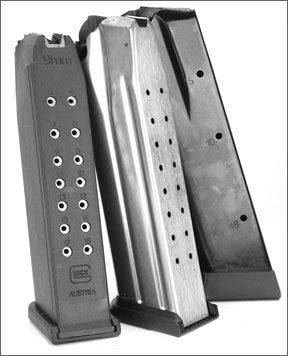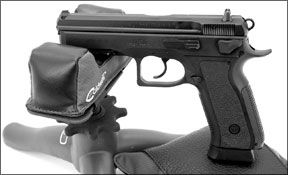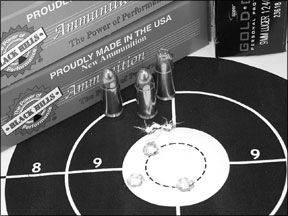If we were to list the reasons for the boom in popularity of the semiautomatic handgun, high capacity would be at the top. The highest-capacity pistols are typically chambered for 9mm because the cartridges are slender and you could pile a lot of them on top of each other. In this test we will shoot three 9mm pistols that subscribe heartily to the plan of carrying as many rounds as the frame will permit. With the rush on guns and ammo we actually had some difficulty putting this test together, but we found everything we needed at Jim Pruett’s Anti-Terrorist Headquarters.

Each pistol represents the highest capacity available from the respective manufacturer. The $749 Springfield Armory XDM9211HCSP is the 9mm version of the largest-framed Croatian police pistol that was introduced chambered for 40 S&W just a few months ago. The $695 CZ SP-01 Phantom No. 91158 is a fresh variation of the venerable CZ75 pistol. It features a polymer frame with interchangeable panels at the rear of the grip. Our third pistol is a benchmark among high-capacity 9mm pistols. The $680 Glock 34 takes the large-receiver Model 17 and tops it with a longer barrel and adjustable sights. The design of each of these guns has been influenced by the demands of the Practical Shooting crowd and should make ideal weapons for home defense, duty carry, or open carry for the civilian.
With the possible exception of the CZ pistol, the operation of each gun was a known quantity. So our evaluation will spend most of its time and ink on performance and describing a test drive. With maximum available sight radius available on each gun (another benefit of the full-size pistol), we chose to record accuracy data from a distance of 25 yards. For support we used a $49 Caldwell Rock Jr. shooting rest beneath the dust cover of each pistol and a $19 pre-filled Caldwell Elbow Bag to support our hands, both from battenfeldtechnologies.com. The Rock Jr. proved stable without being unnecessarily heavy. The pre-filled bag stayed tight and didn’t compress so much that we had to reset the guns after every shot. With these tools we were able to do our best despite the gusting winds racing across the Texas plains.
To learn more about the rapid-fire capability of each weapon, we created an action test. We placed three targets downrange in a triangular pattern. The central target was directly in front of the shooter 50 feet downrange. The flanking targets were each 30 feet downrange and 15 feet from the center line. The targets were police training targets with a 3-inch circle of Caldwell Orange Peel target pasted at dead center. The drill was to raise the pistol from a tactical low ready (a drop of the sights from the target low enough to give view of the subject’s hands), and engage the targets from left to right with two shots each. Beginning with a full magazine, the drill was fired in six-shot strings until the magazine was empty. The test was concluded when we had exhausted two full magazines worth of ammunition. Our pace was held to about the same for each pistol. We wanted to see consistent hits and collect shooter feedback. This means what the shooter saw and what adjustments had to be made to land the required hits.
Test ammunition consisted of the latest generation of Black Hills 124-grain FMJ remanufactured ammunition and new manufacture 115-grain FMJ rounds. The 124s were used in our multiple-target drill. We also fired 124-grain Speer Gold Dot Hollowpoints, which gave us a scare during our chronograph of the Glock pistol. Without warning one of the rounds appeared to overpressure, causing the G34 to jump violently. Recorded velocity of that round was 1311 fps. This was more than 100 fps faster compared to previous shots through the chronograph. We did not recall a similar experience when firing from the bench, so we do not think this interfered with the accuracy of our data. Range conditions offered amenable temperatures but gusting winds and shifting light. Let’s see what we learned about these three high-capacity sidearms.
CZ SP-01 Phantom No. 91158 9mm, $695
The SP-01 Phantom 9mm pistol is more than a polymer rendition of the steel-framed SP-01 pistol. The original SP-01 was described by many as a model 97B, CZ’s big-framed 45 ACP pistol, chambered for 9mm. The extra weight of this model was supposed to help tame recoil for IPSC shooting in world competition. Indeed, the Production division at the last two IPSC World Shoots has been won by Adam Tyc shooting an SP-01, and this year Team CZUSA shooter Mathew Mink was a close second. To make this gun more attractive for carry, CZ fashioned a polymer frame with a full-length five-groove accessory rail that pared weight by about one-third. But the polymer frame is not just a mold of the original steel pistol. No, the SP-01 is much different—and to our hands much better than the original.

The strong suit of the CZ75 has always been ergonomics, but the Phantom’s polymer frame is a revelation. The sides are flatter than the original design and the stippling on the side panels may be the most functional texture we’ve seen. The faux checkering molded into the front of the grip and on the back strap did not look special, but this rather Spartan pattern proved very effective. If anything, these patterns verge on being abrasive, but we liked them.
The CZ design is unique in that the frame wraps over the rails on the slide. The grip was long enough to accommodate just about anyone’s hand, no matter how large, but the base pad of the 18-round magazine offered about one-half inch of additional pinky rest. The frame was relieved above and behind the trigger area on both sides. Any size index finger hand should be able to reach the trigger without rubbing the frame.
The biggest challenge to shooting any TDA gun is landing the double-action first shot with precision equal to the single-action shots that follow. CZ has made progress toward equalizing the two trigger pulls by shortening the stroke of the double-action shot considerably. We pressed the decocker, and the hammer reset well behind the firing pin. We measured this point to be about one-third the distance from the firing pin that the hammer would travel from its position when fully cocked for a single-action strike. Pressing the trigger moved the hammer rearward only a very short distance before releasing for ignition. But what we did not like about the decocker was that once the lever was depressed, it swung freely up and down between the 3’oclock and 4 o’clock positions. Any shooter with the habit of riding the safety with the strong-hand thumb was sure to decock the pistol accidentally. We found this was more likely to happen while shooting from the bench. When we fired standing, it was not an issue as long as we kept our thumb relaxed and away from the slide or tucked down below the platform. We contacted CZ USA, and we were told that the lever should indeed stay tightly in the up position. This would seem to be a simple warranty repair.
In our action test the target to our left was the one where the first shot was fired double action and the second shot single action. Nevertheless we shot a 5.8-inch group on this target including three shots on the small Caldwell Orange Peel target. On the second and third targets we were challenged with timing our shots with stopping the swing of our muzzle. The remaining targets were engaged single action only, and we felt ourselves get more aggressive with each pass. An even circular pattern of shots about 7 inches across was found on targets two and three. We could see where there was a different rhythm in waiting for the front sight between the double- and single-action press and full-time single-action fire. The double-action press was without takeup. The single-action press required takeup, but it was short and well defined.
From the bench our CZ was fired single action only. We were a little frustrated with the trigger during our controlled press. If we really slowed down we could feel the trigger catching and letting go. The problem did not feel like grit. It more felt like there was a tacky coating on the internal surfaces that created a sticky sensation. We can only imagine how well this gun will shoot with a polished action. That is because our CZ nevertheless shot the tightest groups of our test with all three choices of ammunition. Groups measuring 1.6 inches, 1.4 inches and 1.3 inches were shot firing the Black Hills 115-grain, Black Hills 124-grain and Speer Gold Dot ammunition respectively. Average size groups for these rounds in the same order computed to 2.1 inches, 2.0 inches, and 1.6 inches across.
Springfield Armory XDM9211HCSP Bi-Tone 9mm, $749

The XDM series is a variation of the original issue XD Service model. It was not based on the beefier XD45 pistols. The M series is longer and taller but remains svelte. Our 9mm XDM Bi-Tone was the same pistol as the 40-caliber XDM we tested in our September 2008 issue. The XDM instead offers several changes from the original XD, some cosmetic and some essential. One big difference is that unlike other striker-fired pistols, including the XD, the XDM can be field-stripped without ever having to press the trigger. The 19+1 XDM is also the highest-capacity 9mm pistol in the Springfield Armory catalog, Here is a partial list of features unique to the M series pistols: Interchangeable backstraps, a fresh contour to the frame, new grip patterning, a high-speed low-drag slide release, streamlined sculpting of the slide, and low-mount sights that maximize sight radius by blending with the rear of the slide.
At the bench we learned that the trigger required a take-up of slack and then a press against a firm but not necessarily crisp resistance. We would have liked more definition in the final stroke of the trigger or a longer continuum of engagement. In the end we turned in an average sized group of about 2.6 inches across. Looking back at our test of the 40-caliber XDM, our overall average group was less than 2.0 inches across. It may be a stretch, but if we were to compare the XDM 40 with the XDM 9mm pistol, we would prefer the 40-caliber model. Our shooters said that the big XDM platform felt more at home firing heavier bullets and more powerful ammunition. We think that’s good news for law enforcement, which favors the 40 S&W chambering.
Inserting a fully loaded magazine to begin our action tests, we ran up against a condition shared by our XDM and Glock pistols. Slamming the magazine home with the slide locked back automatically released the slide forward, chambering a round. It may sound convenient, but this can be dangerous. We were able to avoid this by loading the chamber from a partially loaded magazine (six rounds or fewer). In our action test we found ourselves on again/off again finding the perfect press. The first target we engaged had about 65% of its hits in about a 5-inch circle. The remaining shots were spread. The far target showed the least consistent pattern. The key to any rapidfire string is of course not to get ahead of what you can justify visually. Our shooter said he simply needed to slow down. On the last target our shooter felt the most confident, and only one shot wandered from the center of the target. We think the XDM trigger required more fine-motor skill than the other pistols to achieve peak accuracy.
Glock 34 9mm, $680
The last time we tested the G34 was for our October 2005 issue, and its rival was another new Springfield Armory pistol. This was the XD Tactical, Springfield’s first enlargement of their XD Service model. Not much has changed on the Glock 34, and it is still the most popular choice for Practical Shooting competitors, including Dave Sevigny, the most prolific winner in the history of the USPSA Production division. The G34 featured a 5.3-inch barrel on a full-size frame that housed a 17-round magazine. The G34 has a large cutout in the top of its slide. It might just be the easiest way to produce a slide of the proper weight so that reciprocation remains smooth and reliable.
The G34 configuration (shared by the 40-caliber G35) is the only Glock sold with adjustable sights as standard equipment. It was also the first Glock sold with competition-bred options such as an extended magazine release, enhanced slide-release lever, and a 3.5-pound connector that reduced the weight of the trigger pull. The fact that Glock has a head start when it comes to innovations from the world of Practical Shooting should not be underestimated.
In our assessment of the XDM we mentioned that the XD’s trigger required take-up to a definitive point of resistance. The Glock on the other hand offers a feeling of continuous compression. Indeed, that is exactly what is happening. The spring that powers the striker of the XD is almost completely loaded by movement of the slide. The trigger of the Glock does much more of the actual compression. Over the course of this compression we think the Glock shooter is dialed into the process. Results from our accuracy tests showed an average size group of about 2.5 inches across firing full-metal-jacket rounds. This was about the same performance as our Springfield Armory pistol. But when firing the 124-grain Speer Gold Dot ammunition, the G34 was a close second to the CZ.
The first target of our action test showed a 7-inch-wide group almost perfectly centered on the target. The central target furthest from the shooter did not look much different than the left-side target which was engaged first. The group did not show any hits on the 3-inch bullseye, instead forming a circle around it. The target to the right was engaged last. The remarkable aspect of the hits on this target was that it displayed four pairs of snake-eyed hits with the holes less than 1 inch apart. We read this as showing where the shooter stopped on the target to fire his two shots. Consistency from shot to shot was perhaps the greatest attribute of the Glock 34.
0309-FULL-SIZED-PISTOLS-ACCURACY.pdf
0309-Springfield-Armory-XDM92.pdf






























